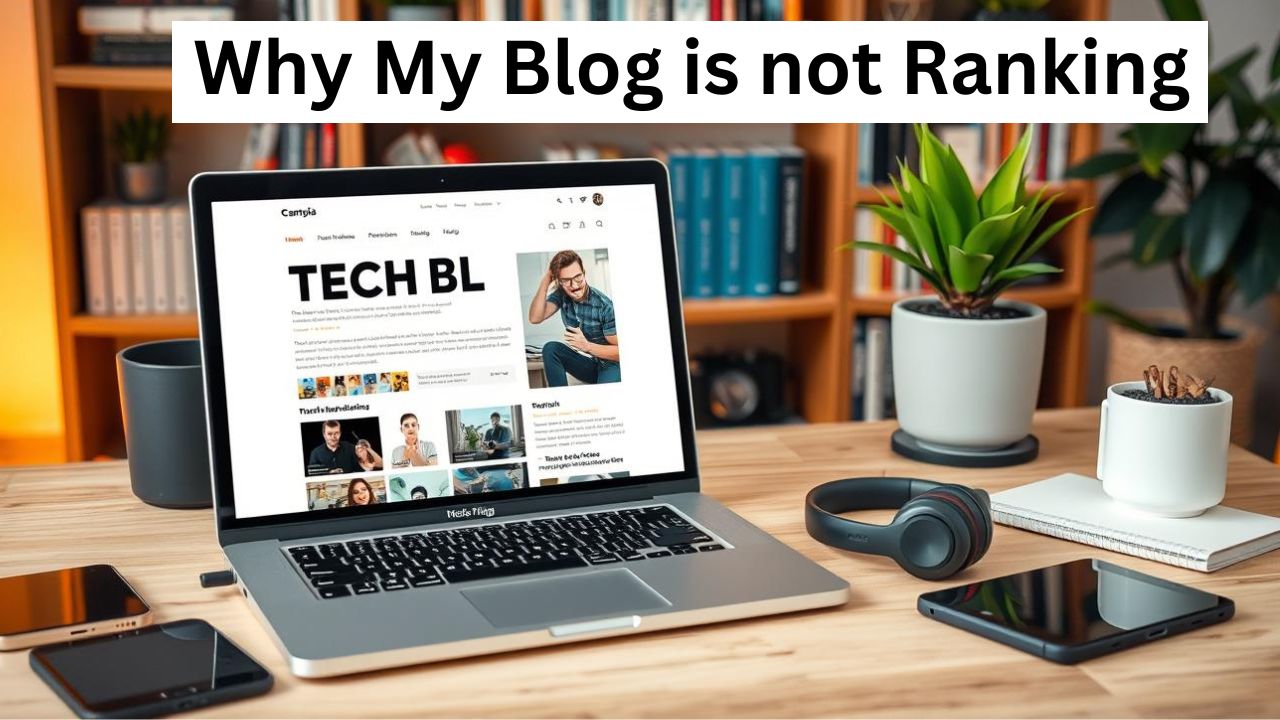My Tech blog is not Ranking Why ?
I’m a tech enthusiast who poured my heart into my blog. I wanted to share my knowledge with the world. But, my blog didn’t get the attention I hoped for. Seeing it not rank well left me feeling frustrated and unsure about my online future.
If you’re in a similar spot, don’t worry. Many tech bloggers face the same challenge. Getting content to the top of search results can be tough. But, there are reasons why your blog might not be ranking well.
In this guide, we’ll look at why your tech blog might not be seen by search engines. We’ll also give you steps to boost its ranking. We’ll cover SEO, creating great content, and more. Our goal is to help your blog reach more people and succeed online.
Understanding Search Engine Optimization (SEO)
As a tech blogger, you might have seen your blog not ranking as high as you want. This is where SEO comes in. SEO helps make your website and content more visible in search results. This can really help your blog get more visitors.
What is SEO and Why Does It Matter?
SEO is key in digital marketing. It makes your tech blog easier to find for your audience. By using good SEO, you can get your site to rank higher. This means more people will see your blog, which can help it grow.
Key Factors in Successful SEO Strategies
Creating a great SEO strategy for your tech blog takes a few steps. Here are some important ones:
- Keyword Research: Find the keywords your audience uses and add them to your content and site.
- On-Page Optimization: Make sure your title tags, meta descriptions, and URLs are clear and relevant.
- Content Quality and Relevance: Write content that’s useful and interesting to your readers.
- Link Building: Get links from other trusted sites to boost your blog’s authority.
- Technical SEO: Make sure your site loads fast, works well on mobile, and is easy to navigate.
By focusing on these SEO strategies, you can improve your blog’s ranking. This will help more people find your site, leading to more growth for your online presence.
“Successful search engine optimization is not about tricks, it’s about building a website for users.”
– Jill Whalen
Keyword Research and Targeting
Effective keyword research is key to a good SEO plan. It helps you find the keywords your audience looks for. This way, you can make content that meets their needs and interests.
Start by making a list of topics and phrases for your blog’s niche. Use tools like Google Keyword Planner, Ahrefs, or Semrush to find keywords with lots of searches but not too much competition. Long-tail keywords are great because they’re more specific and less crowded.
- Identify your target audience’s pain points and search queries
- Analyze your competitors’ keyword strategies
- Explore related and long-tail keywords to expand your reach
- Prioritize keywords with high search volume and relevance
By targeting the right keywords and knowing your audience’s search intent, you can make content that speaks to your readers. This boosts your blog’s visibility in search results. It also brings more traffic to your site, with people who are really interested in your tech content.
“Effective keyword research is the foundation of a successful SEO strategy. It’s the key to understanding your audience and creating content that aligns with their needs.”
Content Quality and Relevance
Creating high-quality, relevant, and engaging content is key for a successful content marketing and content optimization blog. Make sure your articles are informative and solve your audience’s problems. This will boost your user engagement and improve your website’s content quality.
Creating Valuable and Engaging Content
To grab your readers’ attention, focus on making your content both informative and visually appealing. Use a clear writing style and organize your info well. Add images and multimedia to make it more engaging.
- Do thorough research to ensure your content is accurate and detailed.
- Write in a way that speaks directly to your target audience’s needs and interests.
- Use personal stories, case studies, and examples to make your content relatable and interesting.
Optimizing Content for Search Engines
Creating great content is important, but optimizing it for search engine optimization (SEO) is just as vital. Use on-page optimization techniques to make your tech blog more visible and ranked higher in search results.
| Optimization Technique | Benefits |
|---|---|
| Keyword-rich titles and meta descriptions | Boost click-through rates and relevance in search results |
| Optimized header tags (H1, H2, H3) | Improve content structure and hierarchy for better understanding by search engines |
| Image optimization (alt text, file names) | Enhance overall content quality and accessibility for users and search engines |
By using these content optimization strategies, your tech blog’s content will engage your audience and rank higher in search results. This will bring more traffic and engagement to your site.
On-Page Optimization Techniques
Boosting your tech blog’s rankings is easier with on-page optimization. Focus on title tags, meta descriptions, header tags, and URL structure. These elements help search engines and readers understand your content’s value.
Title Tags and Meta Descriptions
Your title tag and meta description are key when your page shows up in search results. Make them catchy and include your main keywords. This can draw more clicks and improve your site’s visibility.
Make sure your title tags match the page’s content and include your target keywords. Keep them short and engaging. Meta descriptions should give a quick overview of what’s on the page. This encourages more people to visit your site.
Header Tags and URL Structure
Header tags (H1, H2, H3, etc.) help search engines understand your content’s structure. Use relevant keywords in these tags to highlight each section’s topic. Also, include target keywords in your URL structure for better on-page optimization.
| On-Page Optimization Element | Best Practices |
|---|---|
| Title Tags |
|
| Meta Descriptions |
|
| Header Tags |
|
| URL Structure |
|
Optimizing these elements can greatly improve your tech blog’s on-page optimization. This leads to better visibility in search results and more traffic to your site.
Link Building and Authority
Improving your tech blog’s rankings is key, and link building is a big part of it. Getting authoritative and relevant backlinks shows search engines your content is valuable. This can lead to better visibility and rankings.
Link building means getting quality links from other sites to your blog. These links are like endorsements, telling search engines your content is top-notch. The more authoritative the sites linking to you, the better your domain authority and off-page optimization will be.
To build links well, create content that others will want to share. Reach out to influencers, partners, and businesses for guest posts or link exchange deals. Also, try broken link building, resource page outreach, and digital PR for quality backlinks.
Quality and relevance of your backlinks matter more than how many you have. Building a strong network of authoritative links can greatly boost your blog’s search engine rankings and visibility.
Technical SEO Considerations
Improving your tech blog’s technical SEO can boost its ranking. Focus on site structure and navigation, and on page speed and mobile optimization.
Site Structure and Navigation
A well-organized site makes it easy for users and search engines to find your content. Use a clear page hierarchy, descriptive URLs, and smooth internal links. This improves site structure and site navigation for everyone.
Page Speed and Mobile Optimization
Page speed is key in today’s fast digital world. Make your blog fast by compressing images, minifying code, and using caching. Also, make sure your blog works well on mobile devices with a responsive design and mobile-friendly content.
By focusing on these technical SEO areas, your tech blog will look great and work well. It will also rank better in search engines, helping you get more visibility.
| Technical SEO Factor | Description | Impact on Ranking |
|---|---|---|
| Site Structure | Logical hierarchy and intuitive navigation | Improved user experience and crawlability |
| Page Speed | Optimized loading times | Enhanced user experience and search engine rankings |
| Mobile Optimization | Responsive design and mobile-friendly content | Increased visibility and user engagement on mobile devices |
My Tech Blog not Ranking, Why?
If your tech blog isn’t ranking as high as you’d like, it’s time to look deeper. Analyzing your blog’s performance can reveal areas for improvement. This includes search engine optimization (SEO), content quality, and user experience.
One common reason for low ranking is poor keyword research and targeting. Make sure your content uses the right keywords that people are searching for. Without this, your blog might be hard to find.
Another SEO challenge is the quality and relevance of your content. Creating valuable, engaging, and well-optimized articles is key. Regularly check your blog performance analysis to find content gaps and areas for betterment.
Technical aspects like site structure, navigation, and page speed are also important. Make sure your website is good for both search engines and users. This can greatly improve your SEO performance.
By focusing on these areas and keeping an eye on your blog’s progress, you can boost your ranking. This will help drive more targeted traffic to your tech blog.
Remember, a well-rounded SEO strategy, combined with high-quality content and a focus on user experience, is the key to unlocking your blog’s full search engine rankings.
User Experience and Engagement
In the world of tech blogging, making your site easy to use is key. Search engines love sites that are user-friendly and meet the user’s search intent. By focusing on a good user experience, you can boost your site’s ranking.
Work on making your blog easy to navigate and fast to load. Make sure it looks great on all devices. This will help keep visitors interested and coming back for more.
Optimizing for User Intent
First, figure out what your audience wants. Look at the keywords they use to find your blog. Then, make sure your content meets their needs and expectations.
Create a plan for your content that solves problems and offers valuable info. This way, visitors can easily find what they’re looking for.
Improving Dwell Time and Bounce Rates
- Write content that grabs and keeps readers’ attention.
- Make your site easy to navigate so visitors can find what they need.
- Speed up your site and make it work well on mobile devices.
- Get visitors to interact with your content by adding calls-to-action and sharing options.
By focusing on user experience and user engagement, you’ll see better dwell time and bounce rates. This means your content is more likely to rank higher in search results. Happy visitors are the foundation of a successful tech blog.
| Metric | Description | Ideal Range |
|---|---|---|
| Dwell Time | The average amount of time users spend on your site before returning to the search results | 2-4 minutes |
| Bounce Rate | The percentage of users who leave your site after viewing only one page | 40-60% |
Competitive Analysis and Industry Trends
To see why your tech blog might not be ranking as well, look at your competitors’ SEO moves. Also, keep up with the latest industry trends. This way, you can spot where your blog can beat the competition and keep your SEO sharp.
First, check out your top tech industry rivals. Look at their content, keywords, links, and SEO success. This SEO benchmarking shows you how to stand out and fill any content gaps.
| Competitor | Monthly Organic Traffic | Top Ranking Keywords | Backlink Profile |
|---|---|---|---|
| TechBlog A | 50,000 | Tech news, industry updates, product reviews | High authority, relevant industry links |
| TechBlog B | 35,000 | Tech trends, software updates, tech tips | Diverse, mix of high and medium authority links |
| TechBlog C | 25,000 | Tech how-to guides, product comparisons | Predominantly high-quality industry links |
Also, keep current with industry trends and search engine updates. This lets you adjust your SEO plans to stay ahead. Your blog will stay relevant and seen by your audience.
“Staying ahead in tech means always watching and adapting. Keep an eye on your rivals and SEO changes to keep your blog ranking well.” – SEO Expert, TechBlog Magazine
Conclusion
To boost your tech blog’s ranking, you need a solid SEO strategies plan. This plan should cover search engine optimization, content quality, and user experience. By following the tips in this guide, you can make your blog more visible online. This will draw in more visitors and help you reach your ranking improvement goals.
This guide has covered the basics of SEO and how to make your content better. It also talked about optimizing your blog’s on-page elements. By doing keyword research, creating engaging content, and focusing on user experience, your blog can become a go-to source in your field.
SEO is a continuous effort. It’s key to keep checking, analyzing, and updating your strategies. By keeping up with new trends and best practices, you can keep improving your SEO strategies. This will help your tech blog stay strong online.
FAQ
Q: What is SEO and why does it matter for my tech blog?
A: SEO stands for Search Engine Optimization. It helps your website show up better in search results. For your tech blog, it’s key because it brings more visitors. This can lead to more readers and business chances.
Q: What are the key factors in a successful SEO strategy?
A: A good SEO plan for your tech blog includes a few things. You need to find the right keywords and make your site easy to use. Also, focus on creating quality content and getting links to your site.
Q: How do I conduct effective keyword research for my tech blog?
A: To find good keywords, look for what people are really searching for. Use long-tail keywords that are specific. This helps your content match what readers want to find.
Q: What makes high-quality and relevant content for a tech blog?
A: Great content for your tech blog should be helpful and well-researched. It should answer your readers’ questions. Make sure it’s easy to read and includes the right keywords.
Q: Why are on-page optimization techniques important for my tech blog?
A: On-page optimization helps your blog rank higher. It includes things like title tags and meta descriptions. These help search engines and users see your content’s value.
Q: How can link building and authority help improve my tech blog’s ranking?
A: Getting good backlinks shows search engines your content is valuable. This can boost your site’s authority. It helps you rank better in search results.
Q: What technical SEO factors should I consider for my tech blog?
A: Technical SEO is important for your blog’s performance. Focus on site structure, speed, and mobile friendliness. A well-organized, fast, and mobile-friendly site improves your ranking and user experience.
Q: How can I identify the reasons why my tech blog is not ranking well?
A: To find out why your blog isn’t ranking, analyze its performance. Look at your SEO, content, user experience, and technical setup. Compare yourself to competitors and industry trends.
Q: How can I optimize my tech blog for a better user experience?
A: Improve your blog’s user experience by understanding your audience. Make navigation easy, content clear, and pages fast. A mobile-friendly design also helps. These steps can boost engagement and rankings.
Q: Why is it important to analyze my competitors and industry trends?
A: Analyzing competitors and trends helps you improve your blog. It shows you what works and what doesn’t. This way, you can make your blog stand out and rank better.
For Tech Videos Subscribe this Channel
Read More
Top 10 Software Companies in World 2024
5 Best AI Tools for Small Businesses in 2024




